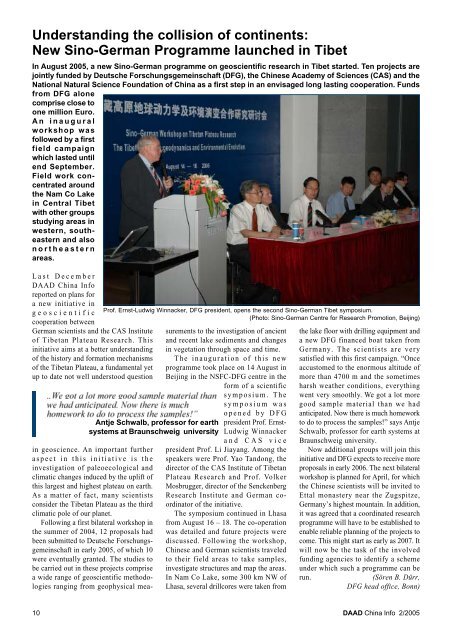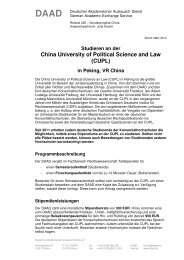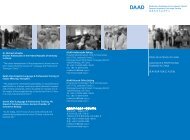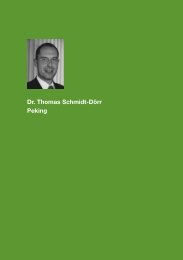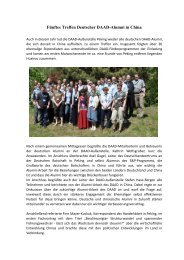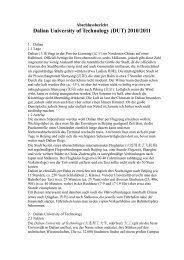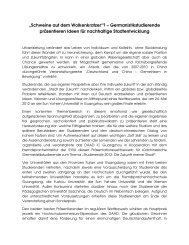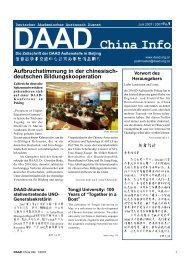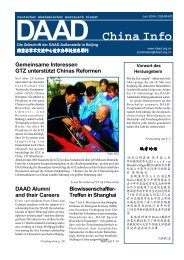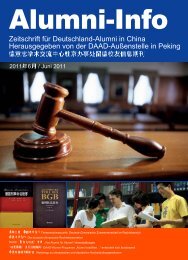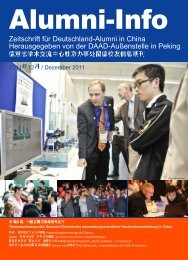China Info - DAAD
China Info - DAAD
China Info - DAAD
Erfolgreiche ePaper selbst erstellen
Machen Sie aus Ihren PDF Publikationen ein blätterbares Flipbook mit unserer einzigartigen Google optimierten e-Paper Software.
Understanding the collision of continents:<br />
New Sino-German Programme launched in Tibet<br />
In August 2005, a new Sino-German programme on geoscientific research in Tibet started. Ten projects are<br />
jointly funded by Deutsche Forschungsgemeinschaft (DFG), the Chinese Academy of Sciences (CAS) and the<br />
National Natural Science Foundation of <strong>China</strong> as a first step in an envisaged long lasting cooperation. Funds<br />
from DFG alone<br />
comprise close to<br />
one million Euro.<br />
An inaugural<br />
workshop was<br />
followed by a first<br />
field campaign<br />
which lasted until<br />
end September.<br />
Field work concentrated<br />
around<br />
the Nam Co Lake<br />
in Central Tibet<br />
with other groups<br />
studying areas in<br />
western, southeastern<br />
and also<br />
northeastern<br />
areas.<br />
Last December<br />
<strong>DAAD</strong> <strong>China</strong> <strong>Info</strong><br />
reported on plans for<br />
a new initiative in<br />
geoscientific<br />
cooperation between<br />
German scientists and the CAS Institute<br />
of Tibetan Plateau Research. This<br />
initiative aims at a better understanding<br />
of the history and formation mechanisms<br />
of the Tibetan Plateau, a fundamental yet<br />
up to date not well understood question<br />
in geoscience. An important further<br />
aspect in this initiative is the<br />
investigation of paleoecological and<br />
climatic changes induced by the uplift of<br />
this largest and highest plateau on earth.<br />
As a matter of fact, many scientists<br />
consider the Tibetan Plateau as the third<br />
climatic pole of our planet.<br />
Following a first bilateral workshop in<br />
the summer of 2004, 12 proposals had<br />
been submitted to Deutsche Forschungsgemeinschaft<br />
in early 2005, of which 10<br />
were eventually granted. The studies to<br />
be carried out in these projects comprise<br />
a wide range of geoscientific methodologies<br />
ranging from geophysical mea-<br />
Prof. Ernst-Ludwig Winnacker, DFG president, opens the second Sino-German Tibet symposium.<br />
(Photo: Sino-German Centre for Research Promotion, Beijing)<br />
Antje Schwalb, professor for earth<br />
systems at Braunschweig university<br />
surements to the investigation of ancient<br />
and recent lake sediments and changes<br />
in vegetation through space and time.<br />
The inauguration of this new<br />
programme took place on 14 August in<br />
Beijing in the NSFC-DFG centre in the<br />
form of a scientific<br />
symposium. The<br />
symposium was<br />
opened by DFG<br />
president Prof. Ernst-<br />
Ludwig Winnacker<br />
and CAS vice<br />
president Prof. Li Jiayang. Among the<br />
speakers were Prof. Yao Tandong, the<br />
director of the CAS Institute of Tibetan<br />
Plateau Research and Prof. Volker<br />
Mosbrugger, director of the Senckenberg<br />
Research Institute and German coordinator<br />
of the initiative.<br />
The symposium continued in Lhasa<br />
from August 16 – 18. The co-operation<br />
was detailed and future projects were<br />
discussed. Following the workshop,<br />
Chinese and German scientists traveled<br />
to their field areas to take samples,<br />
investigate structures and map the areas.<br />
In Nam Co Lake, some 300 km NW of<br />
Lhasa, several drillcores were taken from<br />
the lake floor with drilling equipment and<br />
a new DFG financed boat taken from<br />
Germany. The scientists are very<br />
satisfied with this first campaign. “Once<br />
accustomed to the enormous altitude of<br />
more than 4700 m and the sometimes<br />
harsh weather conditions, everything<br />
went very smoothly. We got a lot more<br />
good sample material than we had<br />
anticipated. Now there is much homework<br />
to do to process the samples!” says Antje<br />
Schwalb, professor for earth systems at<br />
Braunschweig university.<br />
Now additional groups will join this<br />
initiative and DFG expects to receive more<br />
proposals in early 2006. The next bilateral<br />
workshop is planned for April, for which<br />
the Chinese scientists will be invited to<br />
Ettal monastery near the Zugspitze,<br />
Germany’s highest mountain. In addition,<br />
it was agreed that a coordinated research<br />
programme will have to be established to<br />
enable reliable planning of the projects to<br />
come. This might start as early as 2007. It<br />
will now be the task of the involved<br />
funding agencies to identify a scheme<br />
under which such a programme can be<br />
run. (Sören B. Dürr,<br />
DFG head office, Bonn)<br />
10 <strong>DAAD</strong> <strong>China</strong> <strong>Info</strong> 2/2005


